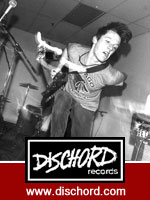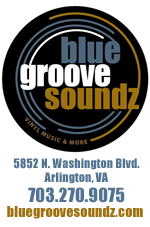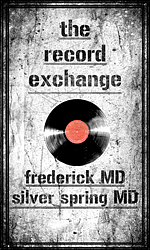
For the our third installment of our monthly all-vinyl residency at Den of Thieves we present Respect the Architects: A Vinyl Odyssey Mapping Future Funk featuring two of DC’s most prolific and ubiquitous selectors: Jahsonic & John Murph. We issued the DJs a challenge to take listeners and dancers on a sonic odyssey mapping the family-tree of “Future Funk” using their extensive vinyl collections to map the course.
Funk is like an apple and there are tens of thousands of varieties of an apple. Enter “Future Funk.” Who is its daddy? How does one define it? Ask any funk expert and you will receive a variety of answers based on subjective tastes. Certainly you could get an academic ethnomusicologist to explain it but how fun would that be? The musical genre called “Future Funk” is so vast and means so many things to different people that it’s hard to pinpoint the mouth of the river from which it springs. So, for our purposes we turn to our topographic DJs—Jahsonic and John Murph—who will map our course at Den of Thieves this Thursday.
There was a plethora of technical innovation for keyboards and guitar effects in the ’60s and lots of musicians jumped right in. I often hear that Sly Stone sits near the source of “Future Funk” with his early ’70s output, specifically on There’s a Riot Going On and later on Fresh. Is it the drum machines? Miles Davis was supposedly inspired by Jimi Hendrix’s wah-wah pedal and put it to use on much of his funk/jazz explorations. Herbie Hancock never shied away from electronic gadgetry and synthesizers but always kept it funky. Noted jazz musician Eddie Harris spawned hits playing his sax with a Varitone effects unit in the late ’60s, but rather than playing bop he was definitely blowing a more groovy funk sound.
If someone were to ask me what an example of “Future Funk” is, I’d probably point to Stevie Wonder’s Clavinet-drenched mega hit, “Superstition” and the futuristic aesthetics of Funkadelic and Sun Ra. Where does “future funk” begin for you?
Murph: I think funk began well before we called it “funk.” You can hear traces of it in black American blues, gospel, and jazz. And certainly in a lot of Afro-Latin and West African music. Just listen to Johnny Lee Hooker’s “Boogie Chillun,” Muddy Waters’ “Mannish Boy,” Bessie Smith’s “Gimme a Pigfoot” to hear clear evidence. Then there’s the inherent funkiness of compositions by Count Basie, Fats Waller, Mario Bauza, Sun Ra, Machito, Charles Mingus, and many others.
Jahsonic: Like most people, I’m going to have to say at the twin poles of Sun Ra and Parliament Funkadelic.
Is there an aesthetic appeal to the vibe of “future funk” that goes beyond the music into artistic design and fashion? I think of Herbie Hancock’s record covers in the ’70s and the video for “Rockit.”
Murph: I certainly believe that funk filtered through other artistic expressions—dance, fashion, visual arts, food, language, even the way that someone walked. Some people just have a funky-ass gait about them. Many funky expressions are both personal and imitable.
Jahsonic: The aesthetic appeal for that vibe was in the optimism of a newly franchised black America and in the opportunity for reinvention that came about as a result. A pre-mythologized future was a chance to invent new folklore, which was very appealing back in the 1970s and ’80s. Combined with the general sense that some kind of techno utopia in which people would be more empowered lay in store and you ended up with some very funky fashion statements and presentations by a few black artists. A similar parallel could be seen in Donald Fagen’s Nightlfly album, although he did the whole optimism concept without the far-out aesthetics.
How are you feeling about the challenge to map our an all-vinyl “Future Funk” night? Are you a musical history buff this way—finding clues in cause-and-effect?
Jahsonic: It forces me to go back into my vinyl collection, pull out, and reconsider albums that I may have only used incidentally in the past. You can never spend too much time with your records.
Murph: I’m embracing the challenge as a personalized journey and sharing of music. We certainly won’t be able to cover the entire scope of funk music. To use the opening lines of Funkadelic’s “One Nation Under a Groove”—funk’s “so high you can’t get over it/so low you can get under it”—it’s that huge.
What I will find fascinating is how possibly Jamil’s and my historical/curatorial sensibilities overlap and interact. He grew up in Washington, DC, so he could bring a high level go-go set to the fore that will take me to school. He’s also far more knowledgable of hip-hop than I am—and his DJ skills are waaaaayyyyy beyond my humble knob-twisting. That said, I grew up in Mississippi, so I know how to get down with jump blues and southern soul. And I dare say, I probably know jazz-funk a little bit more than he does. But we won’t be competing—just sharing our love for funk music—from ancient to future.
What is your primary medium for DJ-ing now? Serato?
Murph: I like the portability of Serato for sure. It’s literally a back saver for a lot of people. But I also LOVE vinyl—the intimacy of it. The fact that you have to care for it; the fact that you have to sometimes search for it; the fact that you can touch it.
Jahsonic: Yes. I use Serato mainly for convenience. I would like to play more vinyl but most venues have serious impediments to doing that effectively.
Do you still dig for vinyl or keep a collection handy that you pull from for Sunday morning listening sessions around the house?
Jahsonic: Both. I love to search for vinyl on my overseas trips. I also keep a choice selection close by for when I’m just at home relaxing or cleaning up. It’s part of my ritual that goes way back to when I was a kid. My mom used to play records all the time when we were doing chores, so that stuck with me.
Murph: Yes, I still dig. I don’t have the room to dig as frequently as I did before. When I crate dig now, I’m usually looking for some specific records. I’m much more discriminating in terms of what I buy now on vinyl.
Did you grow up in Washington, DC or the surrounding area? What record stores would you frequent?
Murph: As stated earlier, I grew up in Mississippi. BUT I’ve been in D.C. for 24 years straight. So I think I can call myself an honorary Washingtonian. This is the city in which I emerged as an adult. As far as record stores, I love going to Joe’s Record Paradise. The store has the largest collection and the staff and owner are always welcoming and knowledgeable about the music. I also dig at Som Records, Crooked Beat, and a few others. I do miss DJ Hut though.
Jahsonic: I grew up in NE Washington, DC. As I kid my mom would take me to all of the old school DC record stores: Waxie Maxies, Kemp Mill, and later on, The Wiz. My favorite though was Sabin’s on Pennsylvania Ave. That was where I heard Stacy Lattisaw for the first time. It had that old school record store feel as well. Not too corporate, ya know? As a teenager, I discovered Road House Oldies up in Silver Spring.
Finally, where is “Future Funk” now? Obviously EDM is all the rage but does “Future Funk” imply a vintage now?
Jahsonic: Future Funk is anything that takes the ethos of the jazz fusion and funk era and brings it forward. Irrespective of when a record was made, Future Funk is about using the tools at hand to craft a vision of times yet to come.
Murph: Hmmm, that’s a good question. The last major breakthrough in electronica music regarding funk that really captivated me was broken-beat. And I think the mainstream crowd is still trying to catch up with that. To paraphrase saxophonist Rahsaan Roland Kirk: “How far back you go can determine how far ahead you can be.” To me that means, the future of funk could be some rare groove that Bo Diddley cut or some things that we probably aren’t yet prepared to hear. So I would say that “Future Funk” is eternally omnipresent.
John Murph is a “diamond in the rough” DJ who specializes in jazz and funk. He’s also an acclaimed music journalist who has written for The Washington Post, The Washington City Paper, The Root, JazzTimes, Down Beat, VIBE and AARP.
Jamil Hamilton, a.k.a “Jahsonic,” hosts the weekly Main Ingredient party at Marvin, holding court on the rooftop and lounge of the 14th and U spot with golden-era hip-hop, deep soul cuts, and the finest music from D.C.’s own scene. He also hosts Behind the Line every Friday at Den of Thieves and has ubiquitous presence as DC selector as well as being a staple guest at Underdog’s Okayafrica DC parties.
The Vinyl District presents Respect the Architects: An All Vinyl Odyssey Mapping Future Funk featuring Jahsonic & John Murph
Den of Thieves
Thursday, September 18
9PM-2AM
NO COVER
2005 14th Street, NW
Washington, DC 20009















